The MSI Optix MAG321CQR is the latest addition to the company’s growing number of gaming monitors. This is technically the MPG27CQ’s bigger brother with the same refresh rate, resolution, curvature and a 1ms MPRT under a 32 inch package.
The MAG321CQR also features an updated Gaming OSD App and a back panel RGB lighting only option on top of the thin bezel design. On this review, we will check out if this somewhat oversized gaming display is a good step up from the MPG27CQ. That’s at least if you are looking for a gaming monitor with a larger screen.
Technical Specifications
| Display | |
| LCD Size | 31.5″ |
| Aspect Ratio | 16:9 |
| Resolution | 2560 x 1440 |
| Refresh Rate | 144Hz |
| Pixel Pitch | 0.2724mm |
| Brightness | 300cd/㎡ |
| Contrast Ratio | 3000:1 |
| Panel Type | VA |
| Response Time | 1ms (MPRT) |
| Connectivity | |
| Display Options | DisplayPort 1.4, 2x HDMI 2.0 |
| USB | 2x USB 2.0 |
| Audio | 3.5mm out |
| Ergonomics | |
| VESA Wall Mount | 100 x 100mm |
| Pivot | NA |
| Swivel | NA |
| Tilt | -5°/+20° |
| Hight Adjustment | 0-130mm |
| Dimensions | |
| Length | 710mm |
| Width | 262mm |
| Height | 510mm |
| Weight | 7.3kg |
Packaging and Accessories
The MSI Optix MAG321CQR comes packed inside a huge packaging, similar to a 32″ TV’s but by a bit thicker. The monitor comes with the following documentations and accessories inside:
- Warranty card
- Quick start guide
- Promotional pamphlet
- Thank you pamphlet
- Wall mount screws
- VESA mount screws
- HDMI cable
- DisplayPort cable
- USB 3.0 cable
- Power adapter
- EU plug
- US plug
Design, Layout and Build Quality
The MSI Optix MAG321CQR is nothing like its MPG series cousins. That said, the design is leaning towards a more elegant theme as opposed to the said series’ gaming oriented one. As for the panel, pixel density is at 0.272mm. I’d say it’s decent enough for our requirements.
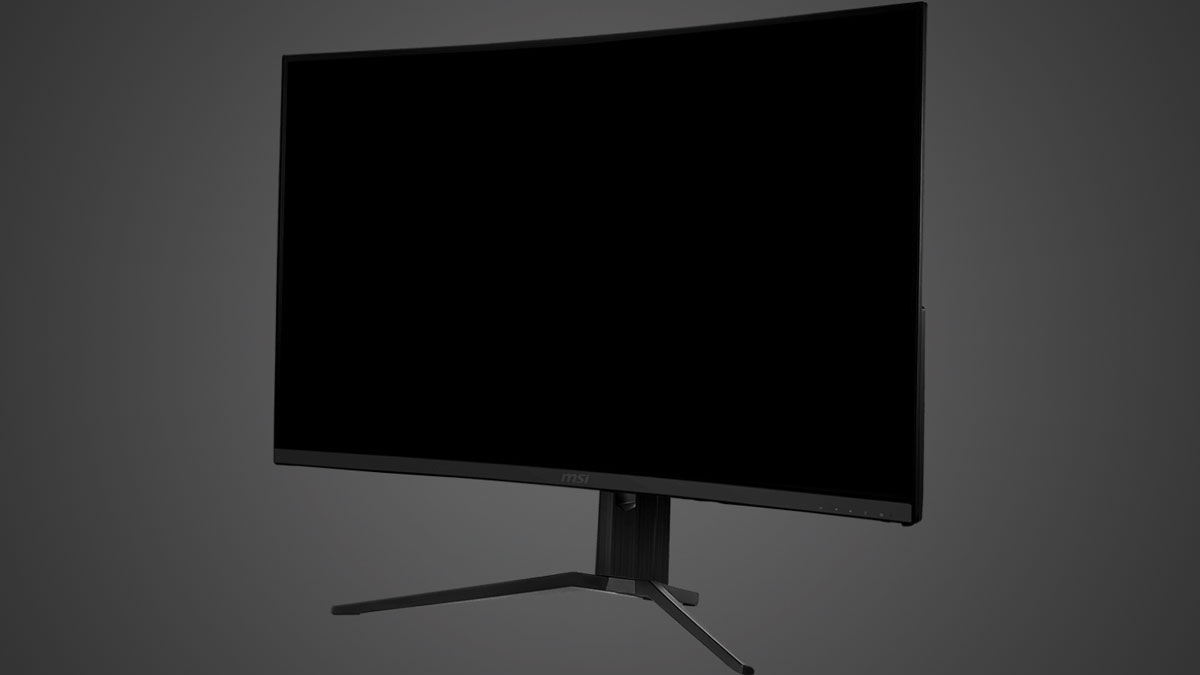
MSI used a blend between gloss and a matte finish coating. A usual feature found on most gaming displays due to its ability to reduce glare while still maintaining clarity. Bezel is thin so putting two or three of these would still look amazing.
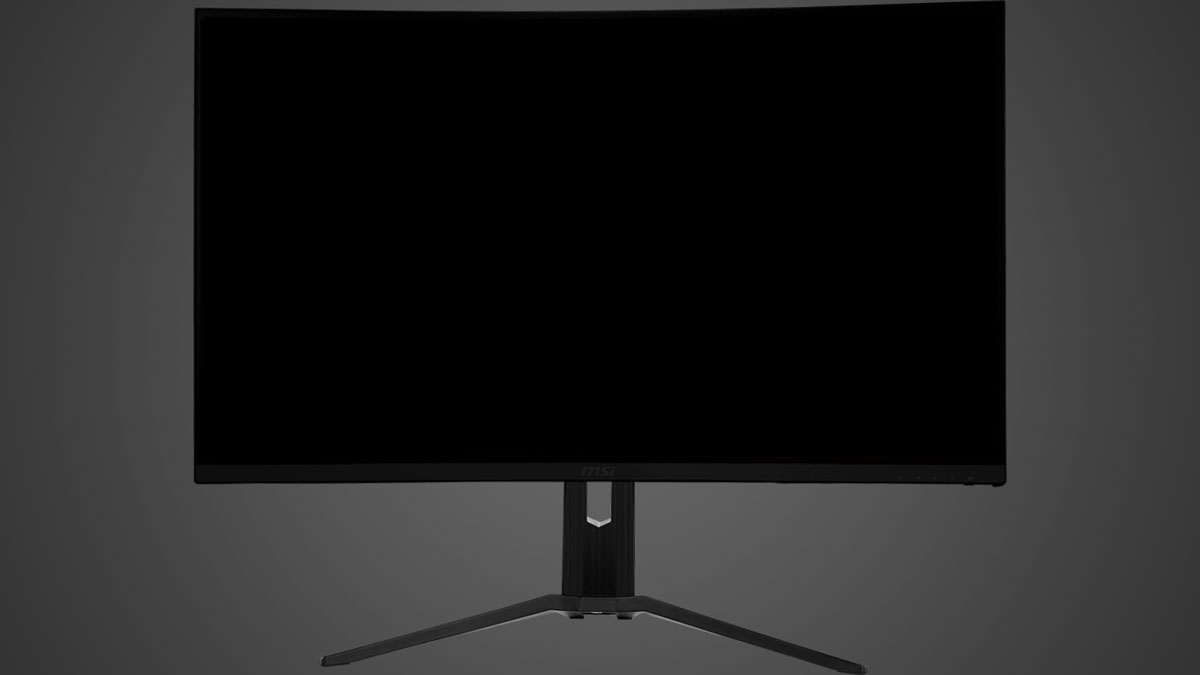
Ergonomically, the MSI Optix MAG321CQR could tilt. The bundled mount wont let it swivel nor pivot though but you could do the former technically. A proper 100×100 VESA mount will solve these ergonomic issues easily. This thing weights in at 7.3 kilograms without the basic mount so a North Bayou F100 or something similar will hold it nicely.
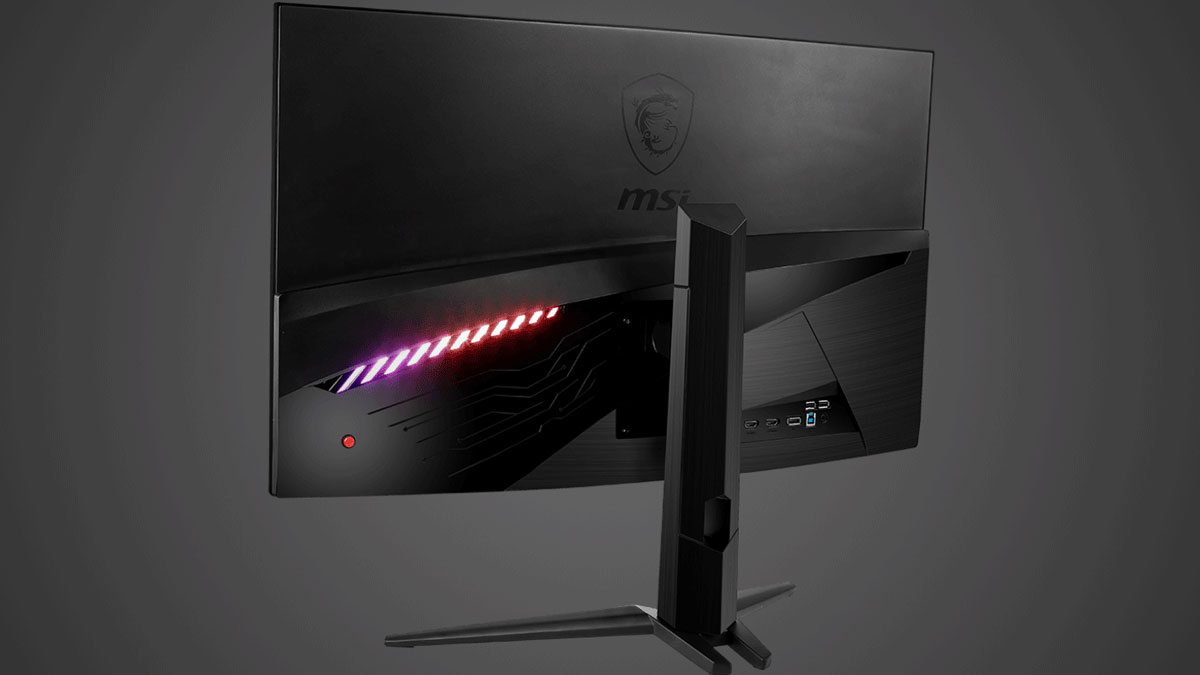
As for display options, MSI went with a dual HDMI and a single DisplayPort. We also got an audio out and two USB 3.0 ports. The joystick on the other hand for the OSD is situated at the far right side. Placement could be a little closer to the edge though.
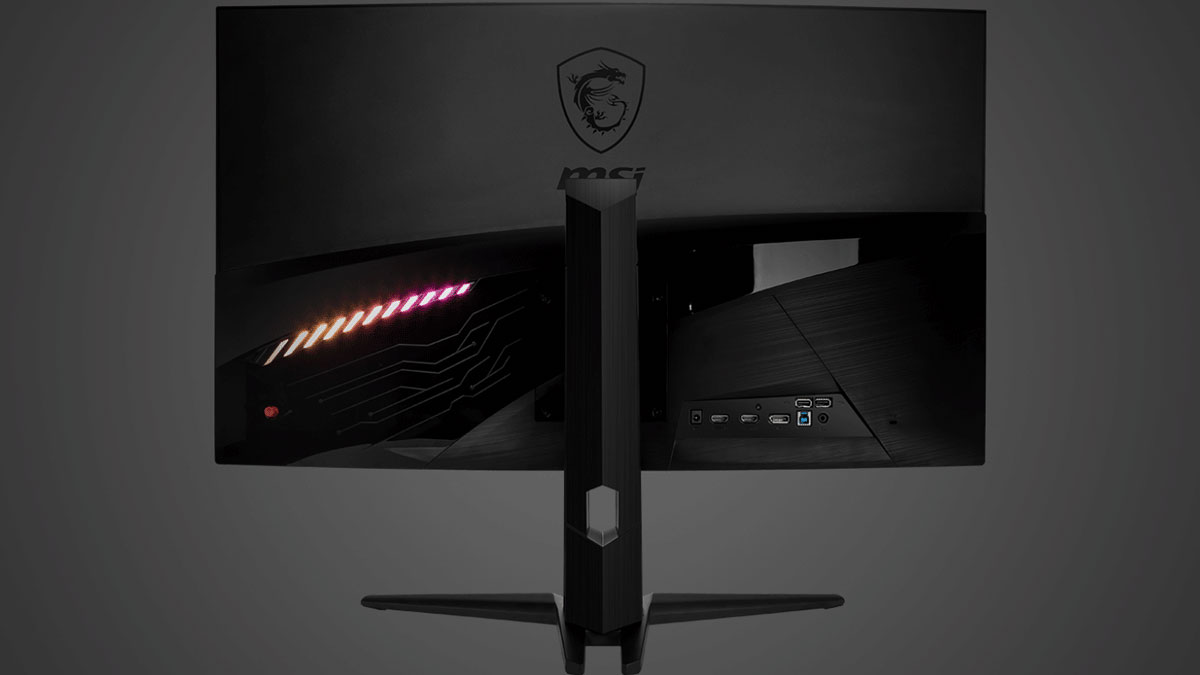
Power is unfortunately external and there’s no speaker to boot. We have programmable RGB LEDs though if that’s your thing.
On-Screen Display Menu
The MSI Optix MAG321CQR features a well thought out OSD menu. We have 7 main menus here with the Gaming mode housing the most common presets and settings. Professional on the other hand also had its own presets with the inclusion of eye care and image enhancement options.

Image and Input Source are self explanatory. No option to set gamma values here though.

The Navi Key menu allows you to set personalized shortcuts for the joystick’s y and y axis. Setting menu on the other hand is self explanatory.

Test Setup and Methodology
Our test setup relies on the Blur Busters TestUFO Motion Tests and the Data Color Spyder5ELITE Display Calibration System. The cameras used throughout the review for the motion artifact and high speed assessments are the Fujifilm XE-1 and the Nikon 1 J1.
| Test System Specifications | |
| CPU | Intel Core-i5 6600K |
| Motherboard | ASUS Z170-A |
| Cooler | Noctua NH-L9i |
| Memory | ADATA Premier DDR4 |
| GPU | ASUS ROG Strix GTX 1060 OC |
| Storage | Crucial BX200 480GB |
| Case | Thermaltake Core P3 |
| PSU | CORSAIR RM850X |
| Display | DELL U2715H |
| OS | Microsoft Windows 10 Pro |
Target for calibration is a 2.2 Gamma value, with a White Point at 6500K and a Brightness value set at 120 cd/㎡. Calibrated values are then analyzed with the Spyder5ELITE Display Analysis tool. Do note that Dynamic Contrast Ratio and other extra features built within the OSD are disabled during the tests. The following OSD values are selected for the display calibration.
| OSD Settings | |
| Brightness | 50 |
| Contrast | 50 |
| Saturation | NA |
| Temperature | Normal |
| Gamma | NA, Black Level 10 |
| Preset | Cinema |
If you wish to use the calibrated ICC profile taken from our Spyder5ELITE result, just send us a message. You may also read our guide on how to use ICC profiles.
Color Gamut:
The Gamut test evaluates the color spaces the display exactly covers. That includes industry standard spaces such as sRGB and AdobeRGB. Higher percentage values are better.
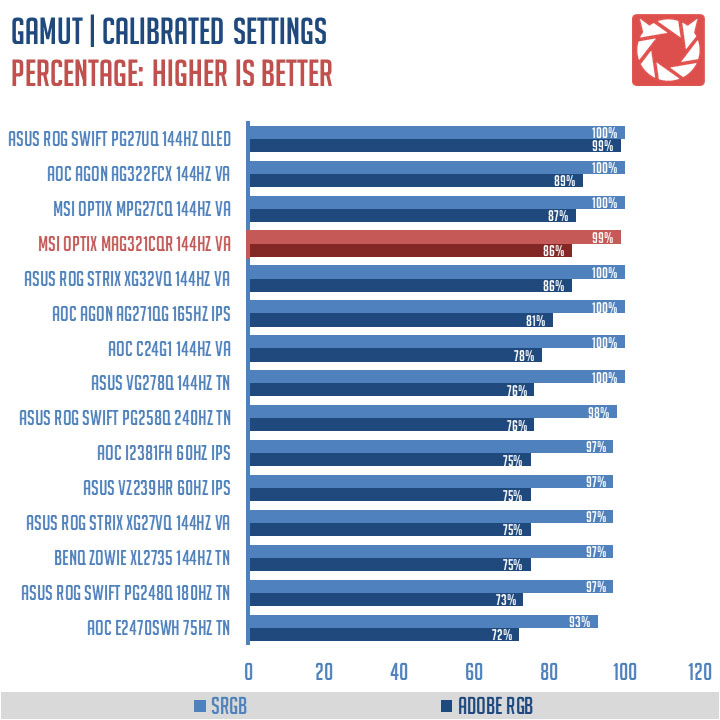
The color space coverage of the Optix MAG321CQR is up there with the best with a 99% sRGB coverage and an AdobeRGB coverage at 86%. Gamut is not everything though.
Tone Response
Tone response is where we check the display’s Gamma values and or presets if there are any. We then compare the results with industry standards of 1.8, 2.2 and 2.4. Closer to these values are better.
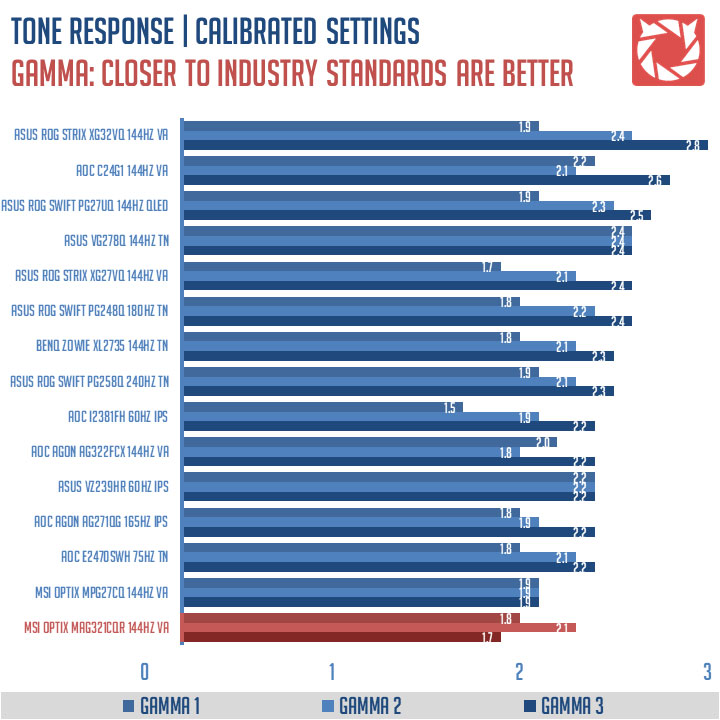
The MSI Optix MAG321CQR doesn’t feature any gamma settings but, you could still somewhat employ crude gamma corrections via the Black Level settings, brightness and contrast itself. A value of 11 will net you 1.7, 10 (default) will get you 1.8 and 9 will net you 2.1. I suggest leaving this option at the default value of 10. The gamma curves from the other values are just not recommended to mess with.
Brightness
The result of the test here will shows us an overview on how the display actually performs in terms of Brightness measured in candela per square meter (cd/m2). Higher is better.
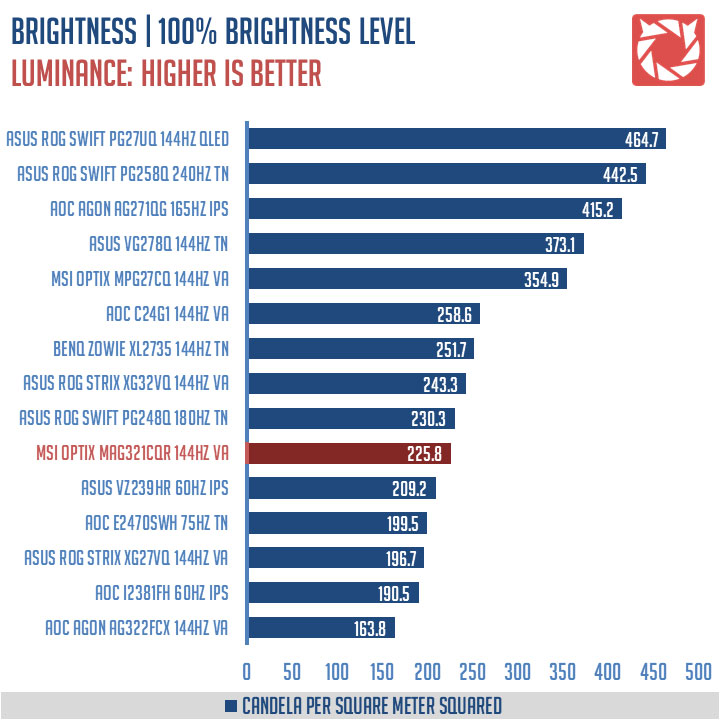
Brightness at 100% is rated at 225.8 cd/㎡ which is lower than the specified, although we could trick it at 231 if we botched the settings.
Contrast Ratio
Static contrast ratio is also tested. The test here will shows us an overview on how the display actually performs in terms of Contrast measured in luminance ratio. Higher is better.
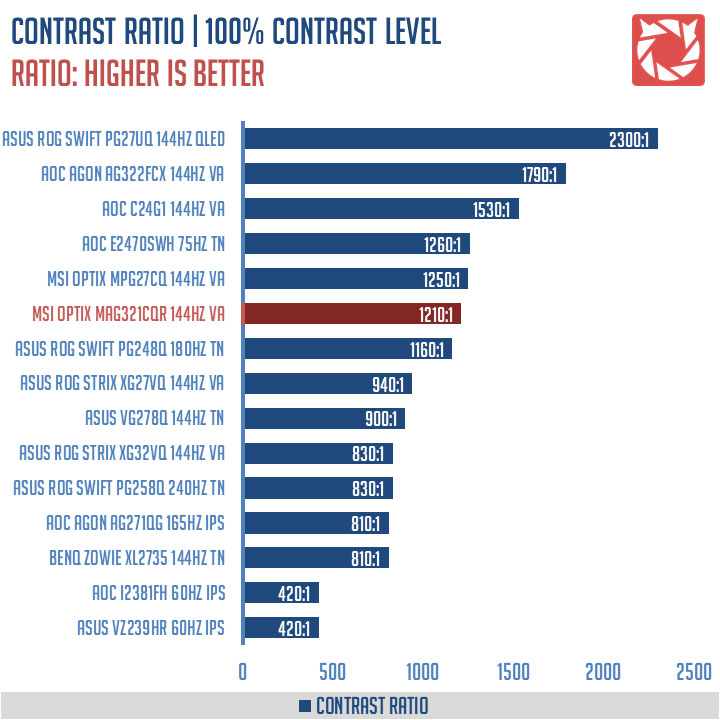
Contrast ratio at 100% contrast level on the other hand is at 1210:1.
Screen Uniformity
This test shows us an overview of the screen’s uniformity at the calibrated brightness level. The closer this value to 0, the better the quality of the panel.
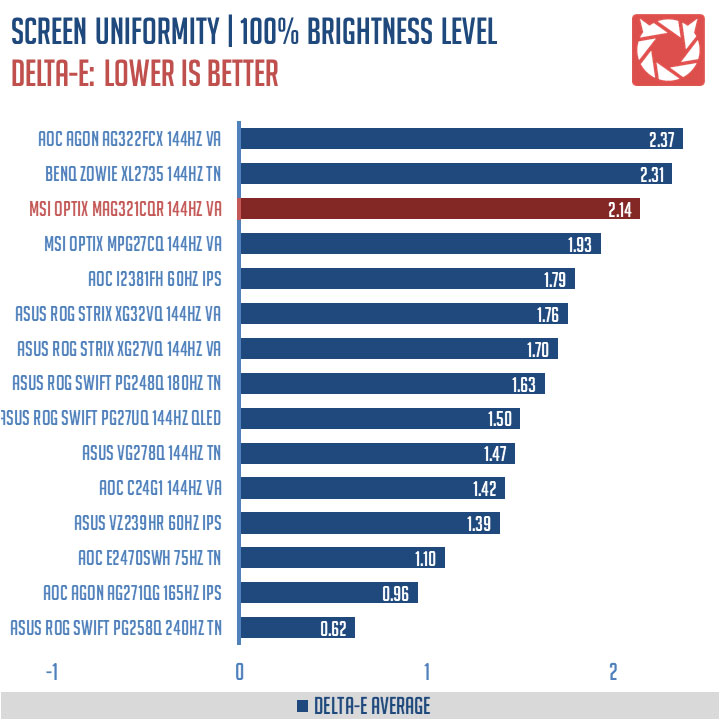
Screen uniformity is what I could say mediocre with a Delta-E value of 2.14 average. The MAG321CQR VA panel had trouble with uniformity at the lower and right sides at the very least. This should hamper its viewing angles.
Color Accuracy
This test shows how well different basic color hues are being reproduced by the display. These color tones correspond with the Datacolor SpyderCheckr. Lower Delta-E values are better.
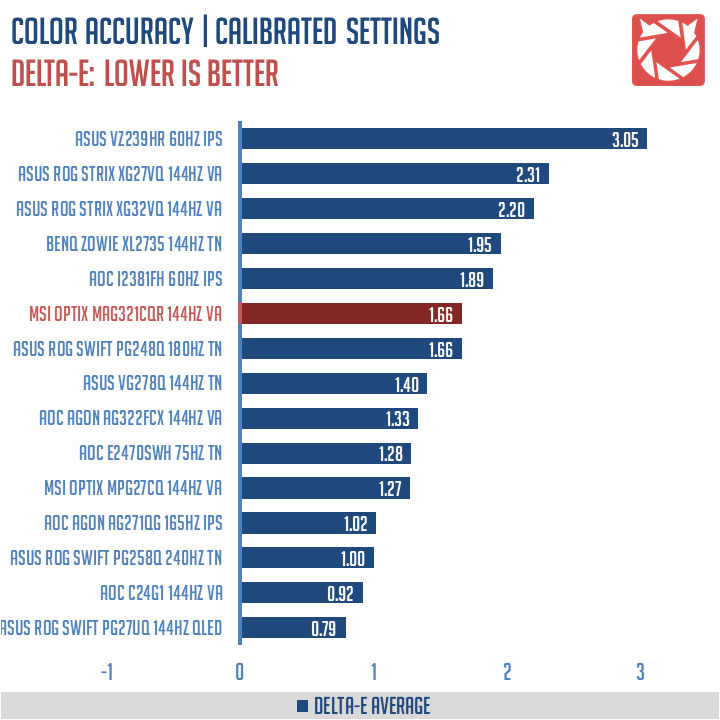
The Optix MAG321CQR scored an average of 1.66 Delta-E value. Middling result we got here for the 32 inch VA panel.
Power Consumption
The power consumption is checked with a power meter. Measurements are taken at maximum brightness level.
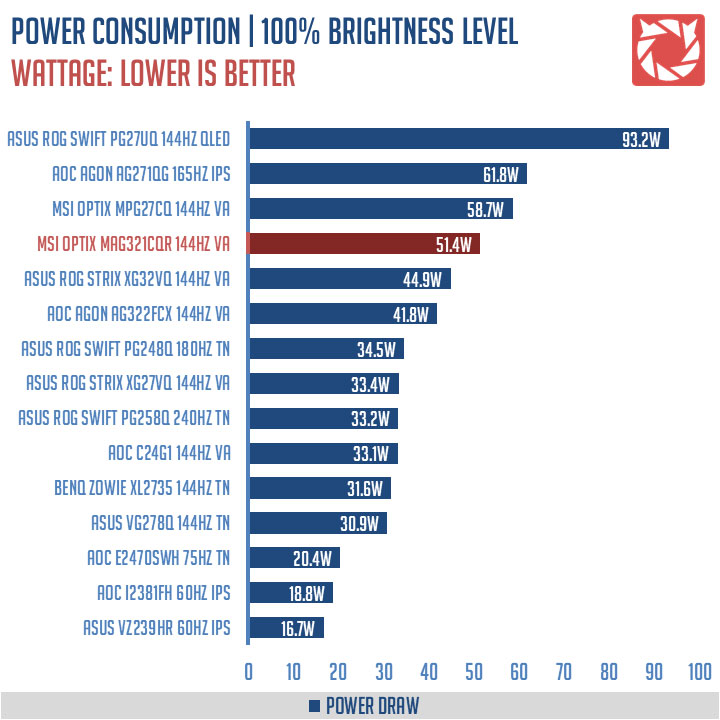
The Optix MAG321CQR consumes maximum power of 51.4W. This goes even lower at 36.5W on our desired 120 cd/㎡ level.
Button to Pixel Input Lag
The Button to Pixel Input Lag is a combination of system latency from the point of input, processing and display output. That is the basic of it and to quantify the approximate Button to Pixel Input Lag, we utilized Quake 3 Arena as our main shooter. The game is set at the native resolution of the panel with the FPS locked at 250. We check how much delay in milliseconds it took the display to actually output the signal via a 1200 FPS high-speed camera with ~0.83ms of accuracy.
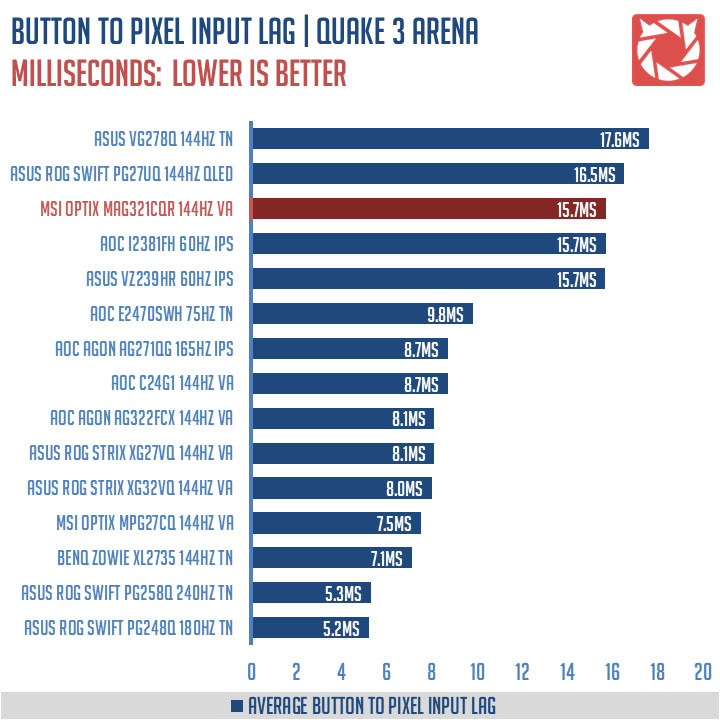
Our button to pixel lag results shows that the MSI Optix MAG321CQR has an average of 15.7ms of latency. Not the best, but not the worst either.
Motion Clarity: MPRT
Motion Picture Response Time (MPRT) is the numbered approach to demonstrate the level of perceived motion blur on a display. Basically, a lower persistence value indicates less motion blur. Refresh rate and the sampling method plays a major part here whereas a higher refresh rate nominally features better display persistence values.
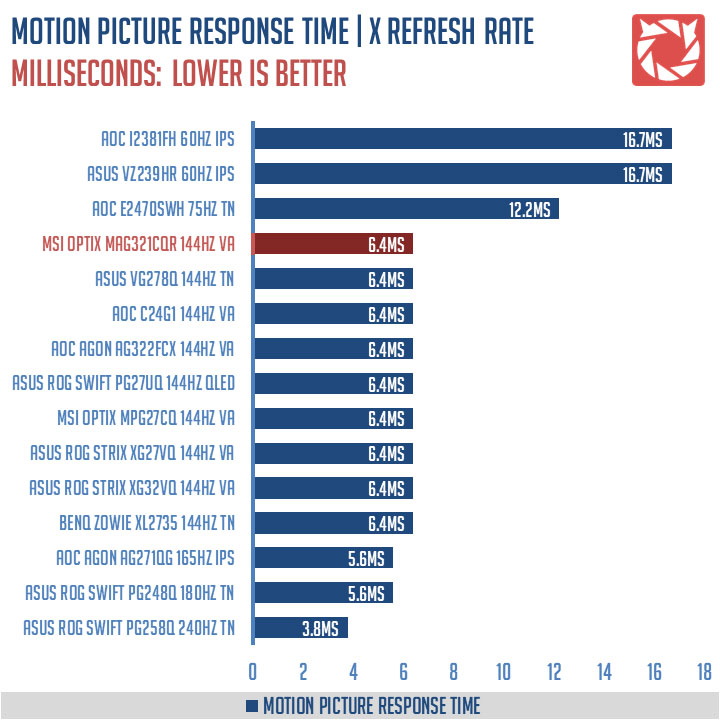
Assessing the typical display persistence is easy enough with sample and hold displays, while CRT and Strobe Lighting enabled displays are quite difficult to test with the current tools available. That said, these are still good references to check out. Especially true if we’re looking for differences based on refresh rates alone.
Motion Clarity: Pursuit Camera
Setting up a pursuit camera courtesy of Blur Busters allows us to a great extent, perceive the actual motion blur of the display. Using such method also allows us to check out for other motion artifacts including ghosting, inverse ghosting and other artifacts. This pursuit camera test is a peer-reviewed invention.
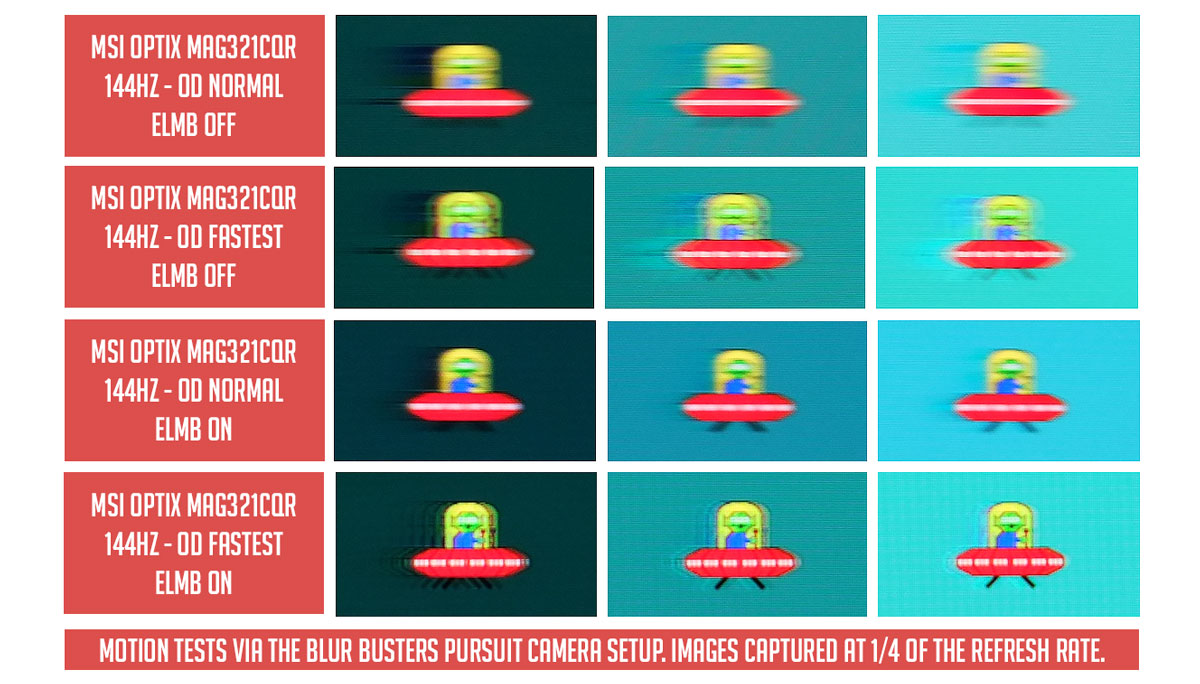
Motion clarity wise, we are looking at a display with around 1-2ms MPRT – as far as our pursuit camera rig is concerned. Overdrive is best set at the strongest level with motion blur deduction turned on, but it is not advisable with the said feature turned off due to a more prominent appearance of overdrive artifact.
Backlight Bleed
Backlight Bleed is the phenomenon where backlighting from a display leaks. This is prevalent with LED backlight enabled displays where the LEDs used to light the panel are situated at the edges of the display. Testing the Backlight of the display is conducted on a dim room, simulating the recognizable amount of bleed for such scenario.
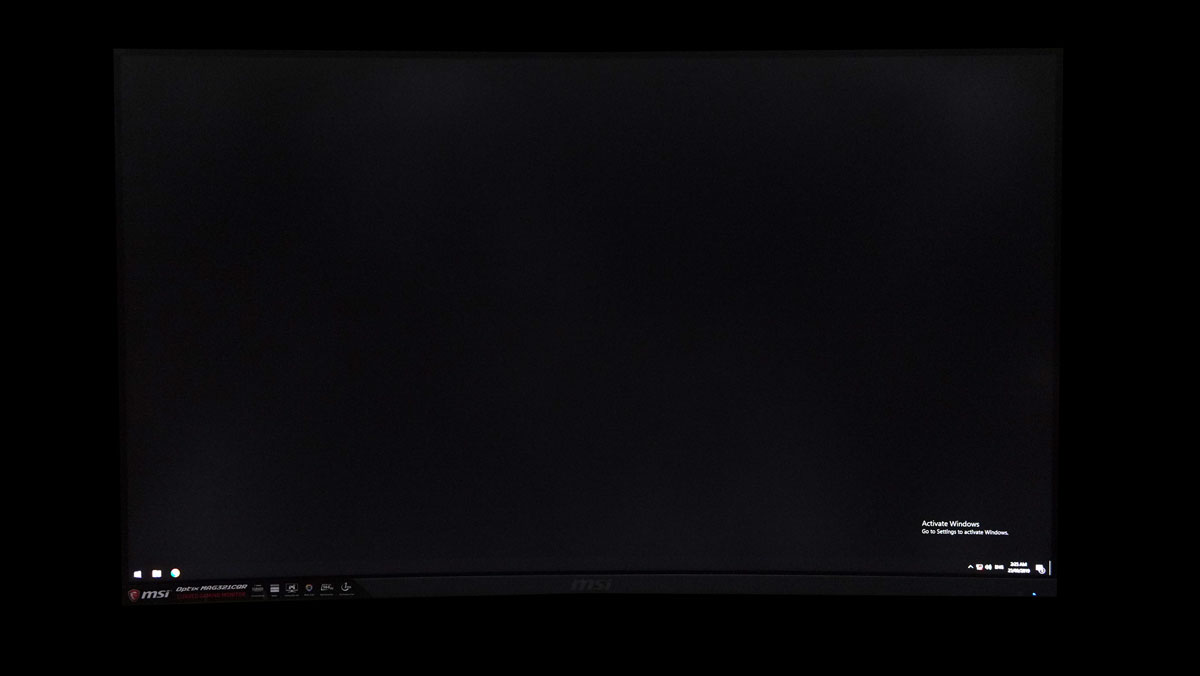
The backlight bleed of the Optix MAG321CQR is a bit visible around the edges of the screen. Though you wouldn’t really notice it unless you bump up the brightness or really looked for it around 120 cd/㎡.
Viewing Angles
Viewing angles are also tested to check out how the display panel performs on various positions. This should be helpful if you are looking for a panel that could be used on multi-monitor setups.
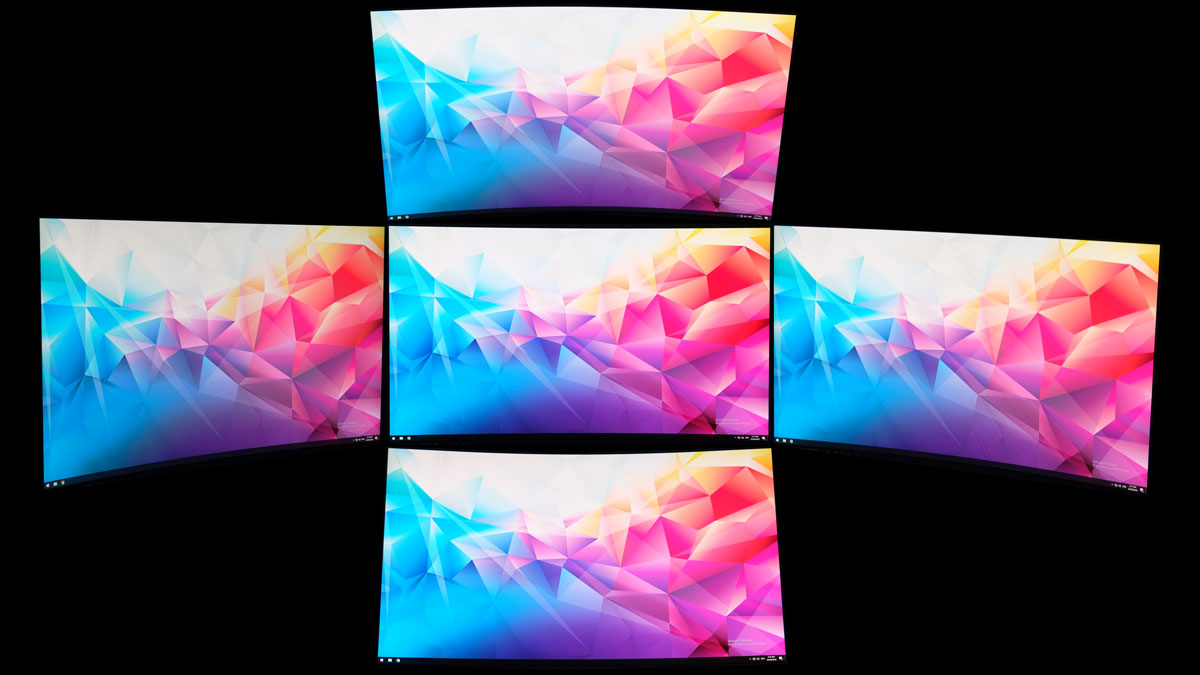
Viewing angles are decent enough. As expected from a VA panel.
Frame Skipping
Frame Skipping is the phenomenon where dropped frames and missing refreshes occur due to ineffective refresh rate overclocking. If your display exhibits such issues, it should be perceptually similar to in-game frame skipping. We are are utilizing the Blur Busters Frame Skipping Checker to test if there is any.
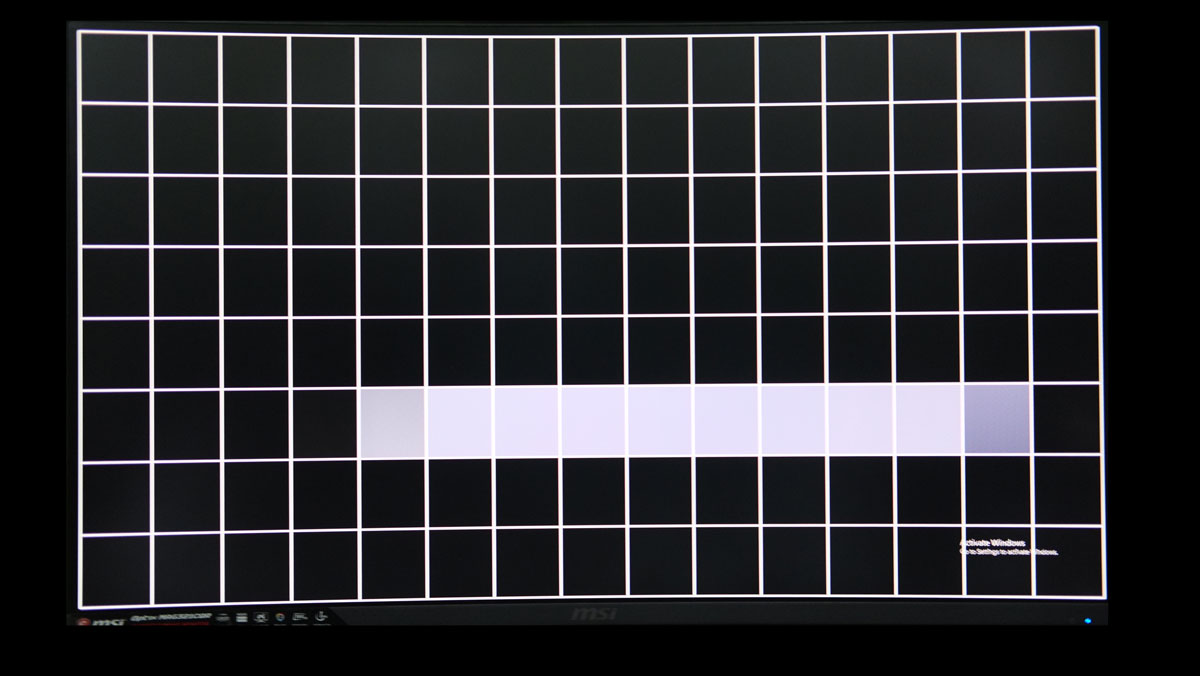
No worries here when it comes to our frame skipping test.
Software, Lighting and Special Features
The MSI Optix MAG321CQR supports a maximum of 144Hz so it’s pretty smooth and responsive. Plus, it features a 1800R curved panel. In practice, curved displays should alleviate eye strain over flat panel displays with an enhanced FOV. This makes more sense with monitors over televisions due to the proximity of the user to feel any difference.

If you’re the kind of gamer who’d trade your soul just to eliminate tearing, then AMD FreeSync is for you. Setting it up is breeze and it’s an excellent way to eliminate tearing. Dipping to lower frame rates and shooting up again also feels smoother with the feature turned on.

Of course, MSI’s Anti-Motion Blur is also one of the stars of the show. We’ve seen how it works on our pursuit camera test and frankly speaking it works. If you could pump out the required frames, this is highly recommended for competitive gaming. Note that brightness will be considerably lower too.

Another feature worth mentioning is the MSI Gaming OSD. It is basically a Windows based user interface equivalent of the OSD menu within the Optix MAG321CQR.
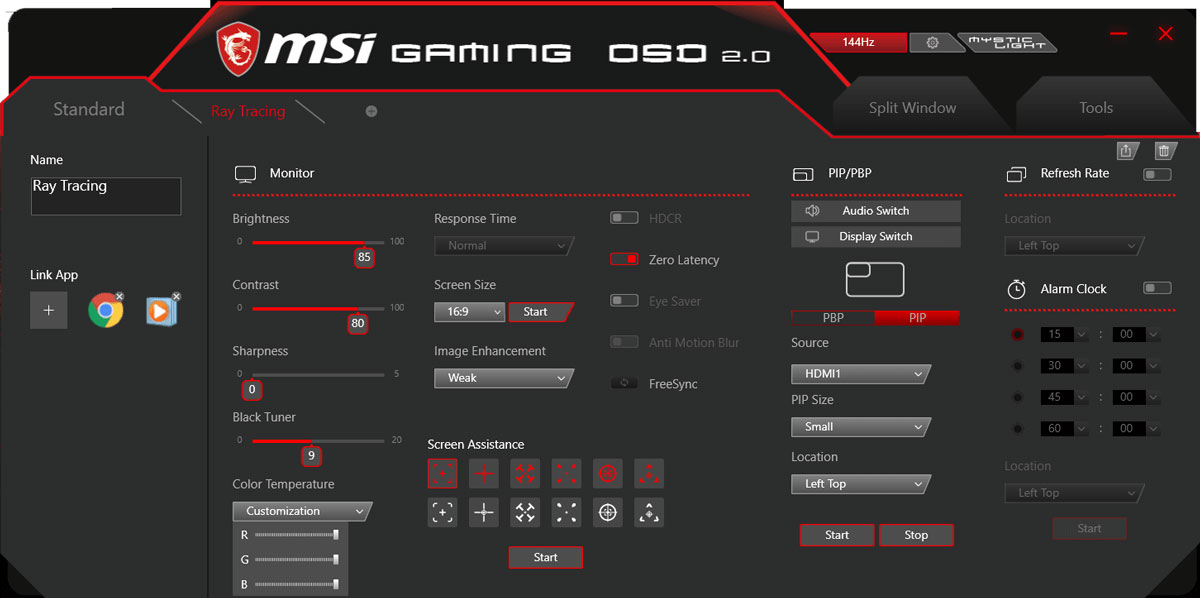
The MSI Gaming OSD has become a novel addition, even way better than the last implementation with extra features in tow. That includes the much appreciated Split Window (PiP) mode.
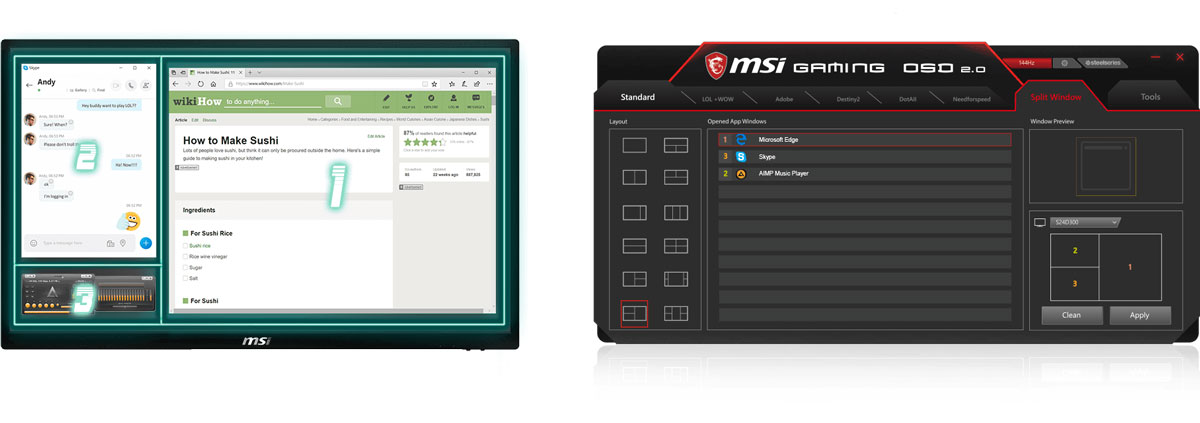
MSI also had the Gaming Echo feature which is just a cheeky way to name a crude audio activated RGB LED equalizer.
Final Thoughts
The Optix MAG321CQR is overall a rock solid 144Hz curved gaming monitor from MSI. Despite its flaws, it managed to impress us with its build quality, set of features and a VA panel that does the designated job just fine. That includes the much appreciated low MPRT with the motion blur reduction turned on, the good contrast ratio, easy to navigate OSD and the good amount of connectivity options.
Of course, this is also a 1440P panel so make sure to equip yourself with a capable graphics card around the lines of the GTX 1070 Ti and equivalent. The monitor also needs proper calibration to get a decent gamma curve which is highly appreciated especially at higher brightness levels. On this topic, I’d like MSI to update the OSD to feature such an option to change the default gamma levels without requiring to mess up other settings.
At 32500 Pesos, the MSI Optix MAG321CQR is decently priced for a 1440P curved VA panel with 144Hz refresh rate. It is certainly not the best at the designated price point yet it is not the worst either. What’s certain though are its set of features made specifically for gaming and gaming alone. A capable choice and something I could recommend myself if you are exactly interested on its strong points.

MSI Optix MAG321CQR 144Hz VA Curved Gaming Monitor
-
Performance - 8/10
8/10
-
Build Quality - 8/10
8/10
-
Features - 9/10
9/10
-
Design - 8/10
8/10
-
Value - 7/10
7/10
Summary
The Optix MAG321CQR is overall a rock solid 144Hz curved gaming monitor from MSI. Despite its flaws, it managed to impress us with its build quality, set of features and a VA panel that does the designated job just fine.
Pros
- Good contrast levels
- Brightness levels
- Ergonomics
- Build quality
- Anti-motion blur support
- Adaptive Sync support
- Refined MSI Gaming OSD
- Connectivity options
Cons
- Gamma curves
- Static gamma
- Screen uniformity
What monitor do I go for.. The MSI Optix MAG321CQR or the Gigabyte Aorus AD27QD??
https://www.rtings.com/monitor/reviews/aorus/ad27qd
(I want the best color representation with the lowest amount of input lag. I’m running a core i9 alongside a 1080ti so Freesync should work just fine)
Thanks!
Purely for specs alone, GIGABYTE is the winner.
Thank you so much! Just ordered one.
Kindest greetings from the Netherlands!
Thanks so much! Ordered the Aorus =D
Would it be better to get this or the MPG27CQ?
I have this monitor and I’m having issues with G-Sync compatibility. When I turn on Freesync in the OSD the option comes up in the Nvidia display control panel, but then I check enable and then click apply it just unchecks the box and does nothing. I have tried drivers from 417. – 419.67 and have even installed the driver from the MSI website. I’ve done a cleancI stallsof windows and even checked with a RX580 to see if Freesync is working (doesn’t appear to be). I have found 5 others with this same issue online, and I was wondering if you can check to see if your monitor from the review exhibits the same behavior.
Hello,
FreeSync works like a charm on my unit, although before I could test G-SYNC compatibility, I’ve already returned it to MSI.
Do you recommend this one or the MPG27CQ
I would recommend the MPG27CQ over this one for a couple of reasons:
1) Better pixel pitch.
2) Higher brightness levels.
3) A bit better contrast ratio.
4) A more uniformed screen (both are middling still).
5) Better color accuracy.
6) Best in class input lag.}
I hope it helps!
The price if this has been lowered in PH. You can get one at about php 26k
What is the diff with mag322cqrv?
Hello, I recently purchased this monitor but think I might have to return it after experiencing some heavy ghosting issues. Your review does not mention any issues with ghosting and I was wondering if you could share what settings you used. I am running the monitor on an RTX2070 (this monitor apparently supports G-Sync according to Nvidia). Hopefully I can get this monitor to work well enough for me. Thank you